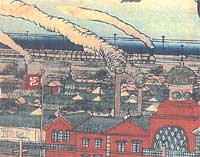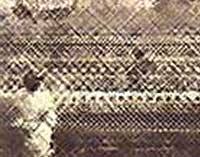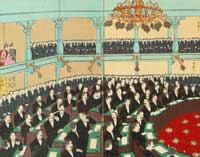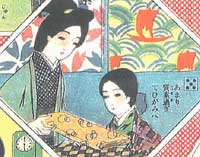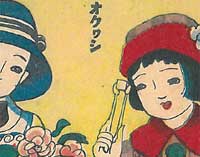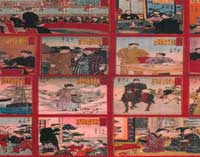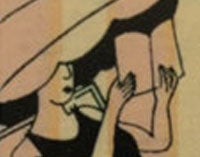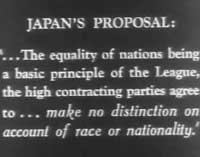Becoming Modern:
Early 20th-Century Japan through Primary Sources

Becoming Modern: Early 20th-Century Japan through Primary Sources offers secondary teachers seven lessons that examine a critical period in Japanese and world history: the period of Japan’s modernization and international expansion from the 1880s through the 1920s, a time span overlapping the late Meiji, Taishō, and early Shōwa periods. The lessons draw upon a range of historical source materials—including art, literature, memoir, interviews, and government documents—to teach Japanese history using pedagogical approaches that address national content standards and Common Core skills. This curriculum is a project of the National Consortium for Teaching about Asia (NCTA) at the Program for Teaching East Asia (TEA), University of Colorado.
Meiji and Taishō Japan: An Introductory Essay
Historian Ethan Segal notes that Japan underwent far-reaching transformations from the late 19th to early 20th century, creating critical questions for its government and people. How could the Japanese create a shared sense of national identity? Did “modern” mean “Western”? Could Japan modernize and industrialize without losing its sense of self? These were questions Japanese of the time asked themselves and historians ask today as they consider these decades of Japan’s history. Segal's essay provides a brief overview of key events in Japan’s Meiji (1868-1912) and Taishō (1912-1925) periods and the processes of creating a unified, modern nation.
Voices from the Past: The Human Cost of Japan’s Modernization, 1880s-1930s
In many world history curricula, study of modern Japan moves quickly from the Meiji Restoration (1868) to the mid-20th century, with a quick overview of the Sino-Japanese and Russo-Japanese Wars as the beginning of Japan’s trajectory towards empire and World War II. The “big idea” taught about Japan in the late 19th and early 20th centuries is that it played rapid “catch up” to the West. The benefits and costs of this rapid modernization are an important story, paralleling the story of the costs and benefits of modernization in the West. In recent decades, historians have researched the modernization experiences of previously unrecorded voices, contributing to a rich social history that draws on memoirs, diaries, newspapers, and other accounts. In this lesson, students tap into such sources to consider the stories of the “under classes” of Japan’s modernization, beginning to build a picture of those who did not experience the prosperity of Japan’s rapid modernization. Students thereby add another dimension to their understanding of the complex process of modernization and some of its costs in Japan.
The Nature of Sovereignty in Japan, 1870s-1920s
In the Meiji period, Japanese leaders looked to European models of constitutional monarchy, adopting a system of imperial government modeled most closely on the Prussian model. As Japan transitioned from the Meiji to the Taishō periods, government and politics were increasingly influenced by Western liberal ideas. Tensions arose between the growing interest in liberal political thinking and the established political context, established through the Meiji Constitution of 1889. This lesson looks at those tensions through close reading of historical texts. Among the questions students explore in this lesson is the guiding question: How did prominent thinkers craft notions of sovereignty in this time period, when the relationship between the voice of the individual and the authority of an imperial state was in flux?
Sugoroku, Japanese board games, have been popular since the 19th century, if not earlier. Starting in the Meiji period, sugoroku games were mass produced and distributed free in magazines and newspapers. Many sugoroku distributed during the Meiji and Taishō eras served a purpose: to educate people about societal ideals. With a positive tone and colorful graphics, “educational” sugoroku taught players what they needed to know and do to be good subjects in modern Japan. In this lesson, students examine a sampling of sugoroku games used to convey national goals, societal ideals and informal education in early 20th-century Japan. Working in small groups, students analyze games, gather data, and share information learned from the games to further develop their understanding of roles and goals for Japanese subjects in Modern Japan, 1900-1930s.
As with any nation, Japan’s modernization in the late 1800s and early 1900s was a complex process. Throughout, the process involved the search for and evolution of new models of organization and function. Japan adapted promising models from some Western nations, who had embarked on modernization earlier in the 19th century, blending those with ideas and structures that would preserve the “Japaneseness” of Japan. This lesson considers the increasingly complex and differentiated society that emerged in the modern Japan of the late Meiji (1880s-1911) and Taishō (1911-1926) periods, using the case study of women’s roles. Students undertake close reading of visual and written texts by and about women, begin to formulate a complex definition of what it meant to be “modern women” at this time, and synthesize their learning through a role play “mocktail” party. In so doing, they consider what Japanese women’s experiences tell us more broadly about modern Japanese society at the time.
What did it mean to be modern, for nations and people, in the early 20th century? One salient aspect of modernity is the dynamic, shifting roles and identity of men and women within society, the economy, and the family. We often look at the shifting roles of women as a lens into the modernization process and experience. Through the Meiji, Taishō, and early Shōwa periods (1868-1930s), as Japan industrialized and modernized, men as well as women experienced this dynamic shift in gender identities. In this lesson, students engage with primary print and visual sources to explore the emergence of new, varied, and modern “male identities” constructed beginning in the late 1800s.
Voices of Modern Japanese Literature
The Modernist movement in American literature is taught through the works of such writers as Hemingway, Fitzgerald, and Faulkner. This literary movement extended around the world, including Japan. Modanizumu, as the term “modernism” was rendered into Japanese in the late 1920s, was a powerful intellectual idea and form of literary expression. The Modern period in Japanese literature overlaps the reigns of three Emperors: Meiji (1868-1912), Taishō (1912-1926), and early Shōwa (1926-1945). Similar to American writers, Japanese writers of the Modern period broke from traditions with new styles, subjects, and themes. Rapid industrialization, social and economic changes and their costs, suffrage movements, education reforms, and nationalism provided rich topics for Japanese writers of the modernist movement. In this lesson, students read three Meiji-Taishō short stories in their historical, cultural, biographical, and literary contexts, considering how individuals reacted to the process of modernization in Japan during the late 19th and early 20th centuries.
The U.S.-Japan relationship experienced increasing tension from the end of World War I to 1933, during which time several pivotal treaties and agreements were negotiated. The period ended with Japan’s crucial decision to leave the League of Nations. In this lesson, students examine a small collection of diplomatic documents from the United States, Japan, and the international community, issued between 1919 and 1933, to consider multiple perspectives on the U.S.-Japan relationship during this time. They also consider how these two nations negotiated an increasingly complex relationship and how nations generally communicate with one another in an attempt to manage relationships. Students apply their analyses by writing their own communication from Japan to the United States or the United States to Japan, trying to maintain peace without making war.
Introduction to the Curriculum Package
The lessons in Becoming Modern: Early 20th-Century Japan through Primary Sources represent the work of a team of National Consortium for Teaching about Asia (NCTA) teacher alumni and NCTA staff members engaged in a one-year curriculum development project entitled “Reading” Japan: Modern Japanese History, Informational “Texts,” and Common Core Skills. Conducted through the NCTA National Coordinating Site at the Program for Teaching East Asia, University of Colorado Boulder, the project was designed as a collaboration of NCTA staff members and experienced NCTA alumni, with project scholars, to explore one period of Japanese history in depth and engage in developing curriculum that would focus on the use of both print and visual informational texts to engage students in historical inquiry. Throughout, the project addressed national content standards and Common Core skills. Fifteen NCTA alumni teachers representing history, literature, art history, and geography were invited to participate in the project, which required a one-year commitment to online and summer coursework, a 10-day writing workshop, and lesson development, critique, and revision. For the project, we chose to focus on a critical period in Japanese and world history: the period of Japan’s modernization and international expansion from the 1880s through the 1920s, a time span overlapping the late Meiji, Taishō, and early Shōwa periods. Within this historical context, project participants considered several guiding questions, which are explored in the lessons of this curriculum package:
- For Japan, what did it mean to be a modern nation? How was modernity reflected domestically and projected internationally?
- Through this period, how was a shared sense of national identity created within Japan? How did Japan modernize and industrialize without losing its sense of cultural identity?
- As industrialization and widespread social, political, and economic changes took shape across these decades, how was Japan’s national transformation experienced by various groups within Japan? How, then, were these experiences expressed through public record, art, literature, memoir?
Design of the Lessons
A goal of this project was to develop lessons that would draw upon a range of historical source materials (including art, literature, memoir, and government records) to teach Japanese history using pedagogical approaches that address national content standards and Common Core skills. The lessons challenge students to work with a range of informational texts to hone essential skills including interrogating documents, developing and applying analytical skills, identifying voice and perspective, constructing arguments, synthesizing information, creating and defending a thesis, and developing speaking and writing skills.
The seven lessons in this collection are introduced by a historical background essay by Ethan Segal, Professor of Japanese History, Michigan State University. The lessons complement textbook coverage by providing case studies or focused examinations of a specific issue or question in the broader history of the period. Each lesson looks at a particular “slice” of the complex narrative of Japanese history during this time, drawing on source materials that represent multiple perspectives. The lessons are designed to stand alone, although they may also be used in tandem with other lessons in this series and other classroom materials.
Each lesson contains teacher background, step-by-step lesson procedure, handouts, answer keys, and links to online resources and national standards. With the exception of three short stories, all informational texts and images needed for student work are included or are provided via URLs for Internet access.
Project Contributors
This project was made possible through the generous support of the Freeman Foundation. The final product—this curriculum package—was also possible due to the excellent work of a group of National Consortium for Teaching about Asia alumni teachers, who committed to this year-long project, engaging in study, research, and application of their knowledge and skills to lesson development.
Lesson Authors
- Sarah Campbell, Ketchikan High School, Ketchikan, AK
- Rebecca Hong, Lick-Wilmerding High School, San Francisco, CA
- Susan Flickinger, Glenbrook South High School, Glenview, IL
- Catherine Mein, Ballard High School, Huxley, IA
- Ted Pierce, Marshwood High School, South Berwick, ME
- Barbara Podkowka, Friends School of Virginia Beach, Virginia Beach, VA
- Christine Schaefer, Woodward-Granger Schools, Woodward, IA
- Lori Snyder, Longmeadow High School, Longmeadow, MA
- Mathew Sudnik, Central Catholic High School, Pittsburgh, PA
- Johanna Lohr Wintergerst, Centaurus High School, Lafayette, CO
Introductory Essayist
- Ethan Segal, Department of History, Michigan State University
Project Staff
- Lynn Parisi, Project Director and Editor, Program for Teaching East Asia, University of Colorado Boulder
- Kathleen Krauth, Instructor and Reviewer, American School in Japan
- Laurel Singleton, Project Editor, Program for Teaching East Asia, University of Colorado Boulder
- Jen Spolnik, Web Designer
Additional Contributors
- Monica Agor, Shalom Torah Academy, Morganville, NJ
- Cynthia McNulty, Oakland Catholic High School, Pittsburgh, NJ
- Robert Pannozzo, Wakefield School, The Plains, VA
- David Paris, East Hamilton High School, Ooltewah, TN
Created 2015 : Program for Teaching East Asia, University of Colorado Boulder.
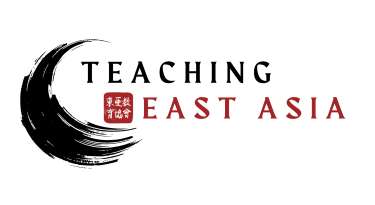
Becoming Modern
- Meiji and Taishō Japan: An Introductory Essay
- Voices from the Past: The Human Cost of Japan’s Modernization, 1880s-1930s
- The Nature of Sovereignty in Japan, 1870s-1920s
- A Window into Modern Japan: Using Sugoroku Games
- Moga, Factory Girls, Mothers, and Wives
- Inventing Modern Japanese Man
- Voices of Modern Japanese Literature
- Negotiating Relationships: United States and Japan, 1905-1933


